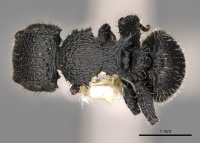Cataulacus greggi
| Cataulacus greggi | |
|---|---|

| |
| Scientific classification | |
| Kingdom: | Animalia |
| Phylum: | Arthropoda |
| Class: | Insecta |
| Order: | Hymenoptera |
| Family: | Formicidae |
| Subfamily: | Myrmicinae |
| Tribe: | Crematogastrini |
| Genus: | Cataulacus |
| Species: | C. greggi |
| Binomial name | |
| Cataulacus greggi Bolton, 1974 | |
Nothing is known about the biology of Cataulacus greggi.
Identification
A member of the guineensis group. The affinities of this medium-sized species appear to lie with Cataulacus guineensis and Cataulacus erinaceus, especially the latter. The production of the posterolateral portions of the pronotal margination is much less distinctly developed here than in erinaceus but is none-the-less quite marked; also greggi resembles erinaceus in sculpturation, strong development of propodeal spines, development of denticulation on the head and alitrunk and form of subpetiolar process. The major differences between them, apart from the development of the pronotal margins lie in size, sculpturation of the first gastral tergite and presence in greggi of a second tooth on the occipital margin close to the dentate occipital corners. (Bolton 1974)
Keys including this Species
Distribution
Latitudinal Distribution Pattern
Latitudinal Range: 1.25° to 1.25°.
| North Temperate |
North Subtropical |
Tropical | South Subtropical |
South Temperate |
- Source: AntMaps
Distribution based on Regional Taxon Lists
Afrotropical Region: Democratic Republic of Congo (type locality).
Distribution based on AntMaps
Distribution based on AntWeb specimens
Check data from AntWeb
Countries Occupied
| Number of countries occupied by this species based on AntWiki Regional Taxon Lists. In general, fewer countries occupied indicates a narrower range, while more countries indicates a more widespread species. |

|
Estimated Abundance
| Relative abundance based on number of AntMaps records per species (this species within the purple bar). Fewer records (to the left) indicates a less abundant/encountered species while more records (to the right) indicates more abundant/encountered species. |

|
Biology
|
Castes
Nomenclature
The following information is derived from Barry Bolton's Online Catalogue of the Ants of the World.
- greggi. Cataulacus greggi Bolton, 1974a: 54, fig. 22 (w.) DEMOCRATIC REPUBLIC OF CONGO.
Unless otherwise noted the text for the remainder of this section is reported from the publication that includes the original description.
Description
Worker
TL 5.2, HL l.28, HW 1.30, CI 101, EL 0.56, OI 43, IOD 1.02, SL 0.62, SI 47, PW I.24, AL 1.40, MTL 0.70.
Occipital crest absent, the occiput and vertex confluent through an obtusely rounded angle. Occipital corners dentate, these teeth flanked upon the occipital margin by a second tooth which is almost as large as that at the corner. Sides of head behind eyes strongly denticulate, the preocular tooth well-developed, separated from eye by a rudimentary second tooth which is smaller and bluntly rounded. Humeral angles acute, the pronotum marginate and strongly denticulate laterally. This margination strongly expanded and with its posterolateral portions expanded into a low, broadly triangular extension which is denticulate upon its borders. Mesonotum and propodeum denticulate laterally but with a gap between the denticulation of the former and that of the latter. Propodeum armed with a pair of long, stout, acute, divergent spines. Sutures absent from dorsal surfaces of alitrunk. Alitrunk broadest across the pronotum, narrowed at the promesonotal junction and then of approximately equal width to the bases of the propodeal spines. Subpetiolar process complex, with a rounded but prominent anteroventral angle and a long, extended posteroventral heel or spur. Subpostpetiolar process strongly developed into a ventrally directed, simple digitiform appendage. In profile the steeply sloping anterior face of the petiole meets the sloping posterior face in a narrowly rounded angle, so that no free dorsal face is differentiated. The postpetiole has strongly sloping anterior and posterior faces separated by a broadly rounded dorsum. First gastral tergite not marginate laterally.
Dorsal surfaces of head and alitrunk with a fine but quite dense rugoreticulum, the interspaces of which are finely and densely reticulate-punctate. Declivity of propodeum with a few transverse rugae between the spines. Dorsal surfaces of pedicel predominantly coarsely and irregularly longitudinally rugose with dense interstitial punctures. First gastral tergite finely and densely reticulate-punctate with a few very weak basigastric rugulae only. All dorsal surfaces of head, body and appendages with numerous simple, blunt, stout, erect hairs.
Paratype. As holotype but slightly smaller and with relatively slightly broader heads.
TL 4.6 – 5.0, HL 1.12 – 1.20, HW 1.18 – 1.26, CI 104 -105, EL 0.50 – 0.54, OO 42 - 43, IOD 0.88 – 0.90, SL 0.60 – 0.64, SI 50, PW 1.08 – 1.16, AL 1.26 – ca 1.40, MTL 0.68 (2 measured).
Type Material
Holotype worker, ZAIRE: Ituri Forest, Epulu, vii. 1955, no. 10 (T. Gregg) (MCZ, Boston).
Paratypes. 2 workers, ZAIRE: Yangambi, x. 1956 (N. L. H. Krauss) (BMNH).
References
References based on Global Ant Biodiversity Informatics
- Bolton B. 1974. A revision of the Palaeotropical arboreal ant genus Cataulacus F. Smith (Hymenoptera: Formicidae). Bulletin of the British Museum (Natural History). Entomology 30: 1-105.



